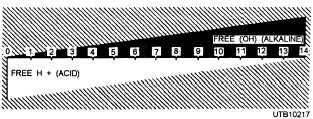SODIUM HYPOCHLORITE is generally furnished as a solution that is highly alkaline, and therefore reasonably stable. Federal specifications call for solutions with 5 and 10 percent available chlorine by weight. Shipping costs limit its use to areas where it is available locally. It is also furnished as powder under various trade names, such as Lobax and HTH-15. The powder generally consists of calcium hypochlorite and soda ash that react in water to form sodium hypochlorite. Ordinary household bleach is a sodium hypochlorite solution containing 2.5 percent available chlorine and is sometimes used at small installations.
CHLORINATED LIME, also known as CHLORIDE OF LIME or BLEACHING POWDER, is seldom used in water disinfection. It is a mixture of calcium chloride and calcium oxychloride that yields about 35 percent available chlorine when fresh. It deteriorates rapidly in a hot, moist atmosphere and should be purchased in small packages that can be kept sealed. Chlorinated lime contains an excess of insoluble lime; therefore, the solution should be prepared in a separate container, the lime permitted to settle, and the liquid decanted into a separate tank for use.
CHLORINE TERMS. - When chlorine gas is introduced into pure water, some of it reacts to form hypochlorous acid, and the rest remains as dissolved chlorine. These forms of chlorine are termed free available chlorine because their oxidizing and disinfecting ability is fully available. Because most natural water contains small amounts of ammonia and nitrogenous organic substances, free available chlorine reacts with these substances to form chloramines and other complex chlorine-nitrogen compounds. These forms of chlorine compounds are termed combined available chlorine because part of the chlorine oxidizing disinfecting ability is lost. Both free available chlorine and combined chlorine react with oxidizable substances in water until their oxidizing and disinfecting ability is depleted. The amount of chlorine consumed in reacting with organic substances in water in a given time (usually 10 minutes) is called the CHLORINE DEMAND. Chlorine remaining in excess of the chlorine demand is the TOTAL CHLORINE RESIDUAL or RESIDUAL CHLORINE. Residual chlorine is composed of both free available chlorine and combined available chlorine. The time elapsing between the introduction of chlorine and use of the water is 30 minutes and is termed the contact period.
BACTERICIDAL EFFECTIVENESS. - The bactericidal effectiveness of chlorine depends upon the pH chlorine residual, contact period, and temperature. The pH value is a measure of the acidic or alkaline nature of the water. The pH of water is technically defined as the negative logarithm of the hydrogen in concentration. The pH value ranges from 0 to 14. A value of 7 is neutral. Values decreasing downward from 7 represent increasing numbers of hydrogen ions. Values increasing upward from 7 represent decreasing numbers of hydrogen ions. A low pH value indicates a very strong acid solution. A high pH value indicates a very strong alkaline solution. The alkalinity of water is the amount of"alkaline" substances in a given sample of water when titrating downward to a pH of 4.2 with sulfuric acid. The acidity of water is the amount of "acid" substances in a given sample of water when titrating upward to a pH of 4.2 with sodium carbonate. The pH value of natural water can vary from 3.4 to 9.0, depending on the impurities present in the water.
The pH influences the corrosiveness of the water, the amount of chemical dosages necessary for proper disinfection, and the ability of an analyst to detect contaminants. The pH scale is shown in figure 7-4.
Chlorine effectiveness increases rapidly with an increase in the residual. However, free available chlorine is 20 to 30 times as effective as combined chlorine under the most favorable conditions of pH (7.0) and water temperature (68F to 77F). Therefore, the relative amounts of free and combined available chlorine in the total residual are important.
Within normal limits, the higher the chlorine residual, the lower the required contact period. If the residual is halved, the required contact period is doubled. The effectiveness of free available chlorine at 35F to 40F is approximately half of what it is at 70F to 75F. The effectiveness of free chlorine is highest at pH 7 and below. At pH 8.5, it is one sixth as effective as at pH 7, and at pH 9.8, it may require 10 to 100 times as long for a 99 percent bacteria kill as at pH 7.
POINTS OF APPLICATION. - Plain or simple chlorination is the single application of chlorine as the

Figure 7-4. - The pH scale.
Continue Reading